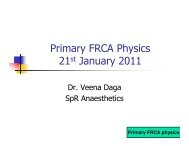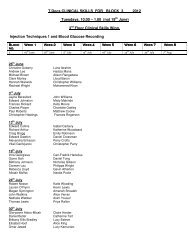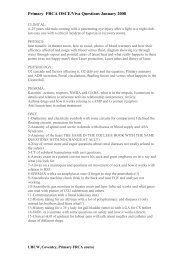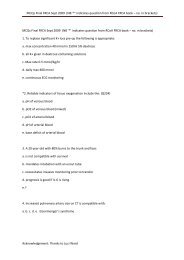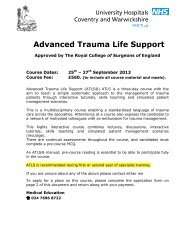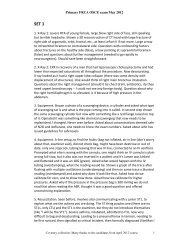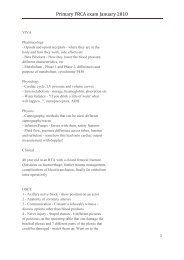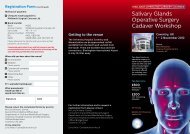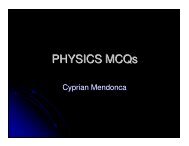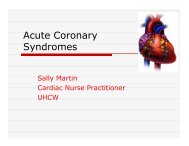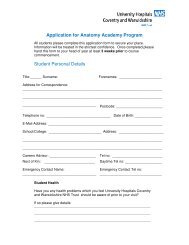Primary FRCA OSCE January 2012
Primary FRCA OSCE January 2012
Primary FRCA OSCE January 2012
- No tags were found...
You also want an ePaper? Increase the reach of your titles
YUMPU automatically turns print PDFs into web optimized ePapers that Google loves.
<strong>Primary</strong> <strong>FRCA</strong> <strong>OSCE</strong>-SOE exam <strong>January</strong> <strong>2012</strong>10) CXR: Again, I’m not sure what this was.11) Resus: Discussion regarding management of asystole (after being shown an ECGtrace)12) A picture of electrical connections to a patient. I really didn’t understand thepicture or the questions. One was something to do with whether the earthpotentials for the different pieces of equipment were equal. They weren’t. What isthe difference between them? What size current causes microshock. Pick 2electrical symbols and explain what they are (there were about 20 to choose from,including BF and CF equipment,13) Anatomy: Diaphragm: Lots of different things labled on a diaphragm (If I recallcorrectly it is the same picture of a diaphragm that is on Wikipedia. Unfortunatelythat was all I could recall here!) Inervation of diaphragm. Other muscles involvedin inspiration and active expiration.14) Anatomy: Spinal cross section and also lables pointing to galgia and nerves fromit. What happens in various spinal syndromes.15) Mono-auricular stethoscope- what is it? What group of patients is it used for?What resp and cardio complications can it detect? What is the characteristicmurmur of air embolism?<strong>OSCE</strong> SET 181. Interactive Resuscitation – Lady for Cat 2 LSCS, after epidural top-up,bradycardic & then asystole.2. Anatomy 1 – Basal skull (with details on trigeminal origin, facial nervedistribution).3. Communication – Lady for appendicectomy, on Methadone for previous Heroinaddiction, worried of relapse.4. Anaesthetic Hazards – Electrical safety in theatres.5. Physical Exam – CVS.6. Monitoring Equipment – Capnography.7. History 1 – Lady with RA for hand surgery.8. Resuscitation Skills – Tachycardia (AF) scenario. Talking through the algorithm& management.9. X-Ray 1 – CXR with ?enlarged thyroid/thymus.10. X-Ray 2 – CXR with ?bilateral hilar mass.11. Simulation – Tension pneumothorax (SinMan).12. Technical Skills 2 – Intraosseous on a child (indication, how to perform,contraindications, paeds fluids management).13. Measuring Equipment – O2 analyser (diagrams).14. History 2 – Laparotomy with recent 2x GI bleed.15. Anatomy 2 – Spinal Cord (very similar to the RCOA guidebook).16. Anaesthetic Equipment – Epidural Pack (what to look for at the pack which hasbeen tampered & how to prepare the epidural set before insertion).17. Technical Skills 1 – Difficult airway management during RSI (this was the teststation).Coventry collection: Many thanks to the candidates from <strong>January</strong> <strong>2012</strong> 14Course



